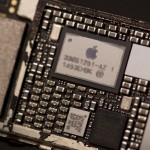
OUR VERDICT
The latest ZenBook 13 from Asus isn’t a speed demon, but it has a killer display and a keyboard that’s as smooth as butter. Plus, it finally addresses a key bugbear in Asus’s laptop design.
FOR
- Decent battery life
- Fast fingerprint sensor
- Stellar display
AGAINST
- Janky touchpad
- HDMI port should be USB-C
- Shell is a smudge magnet
Carrying around a laptop that’s impressively thin, lightweight and yet packs a punch seems to bring about a feeling of confidence on most days. Knowing that a powerful tool is in your backpack or briefcase is reassuring; even more so when that tool doesn’t cost a couple thousand dollars.
Take the new ZenBook 13 as an example: this ultra-portable laptop packs Intel’s latest Core i5 processor, an Nvidia GPU and is more affordably priced than Apple’s MacBook Pro or HP’s latest Spectre 13. Heck, it’s priced the same as Dell’s XPS 13, but with slightly better hardware inside that we’ll get into in a bit.
Price and availability
If you’re in the market for the latest ZenBook 13, you won’t have any options to customize internals in the US. The $999 ( £899, about AU$1,320), price tag gets you the modestly configured laptop you see here.
In the UK, the same model we tested is £899, with a more powerful model featuring a an Intel Core i7 and double the storage will set you back £1,299.
Comparatively, a similarly spec’d HP Spectre 13 starts at $1,149 in the US, or in the UK the Spectre 13 doubles the storage and a 4K display for £1,599.
Apple’s MacBook Pro far exceeds the price point of the ZenBook 13, and is stuck with last generation Intel processors.
We recently took a look at the new Dell XPS 13, priced at $999 (£1,299, $2,299), but without a touch-screen, half the RAM, and half the amount of storage found on the ZenBook 13. All in all, the ZenBook 13 is competitively priced for what it offers.
According to the Australian Asus website, the ZenBook 13 is available across a long list of retailers, however we’ve failed to find a retailer with any stock.
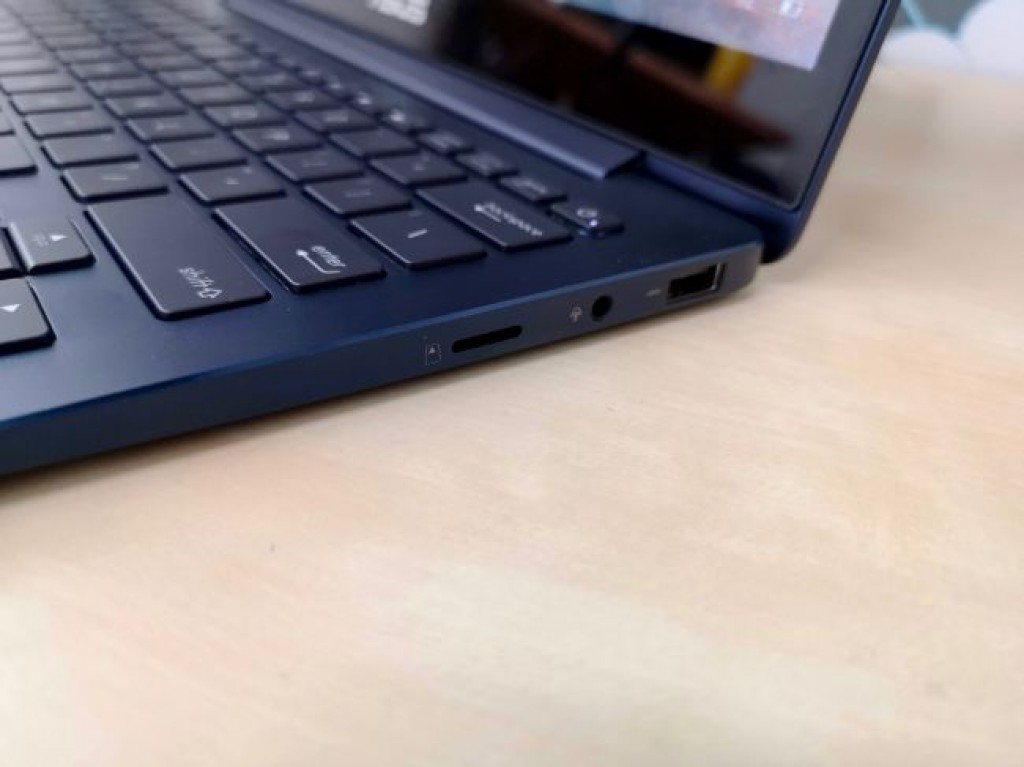
Design
The next time you find yourself frantically looking for a mirror to ensure your hair looks good, just close the lid of the ZenBook 13. It’s not only shiny, but reflective enough to serve as an impromptu mirror for you or your classmates. We tested the royal blue model, but the slate gray model looks just as reflective and shiny.
There are a number of ports on the ZenBook 13. On the right side is a microSD card reader, a 3.5mm headphone jack, and a USB 3.0 port. On the opposite side is where you’ll find a USB Type-C port, another USB 3.0 port and a full-sized HDMI port.
It’s that last port that has us a bit puzzled. Indeed, it’s convenient to have the option to connect smaller laptops such as the ZenBook 13 to external monitors, but we can’t help but think using that space for another USB-C 3.1 port would be far more beneficial than an HDMI port.
A standard keyboard is backlit with a white light and several levels of intensity. The chiclet keys offer 1.4mm of travel and is incredibly comfortable to type on. We use a lot of keyboards, and most take some sort of adjustment before we really get into a flow. With the new ZenBook 13’s keyboard, however, it was love at first type.
The 13.3-inch display is surrounded by 6.8mm Asus’s NanoEdge bezels. The touch sensitive display is smooth and responsive to our fingers. We didn’t have an Asus Pen to test on this particular unit, but that is an option with the ZenBook 13 should you want a stylus for jotting notes and drawing. One thing to note, however, is that the hinge does not let the display fold flat, so you’ll have to adjust to drawing with the screen in a standard laptop-like orientation.
Even though the display is FHD (1,920 x 1,080), it’s incredibly sharp and leaves the impression of being of a higher-resolution.
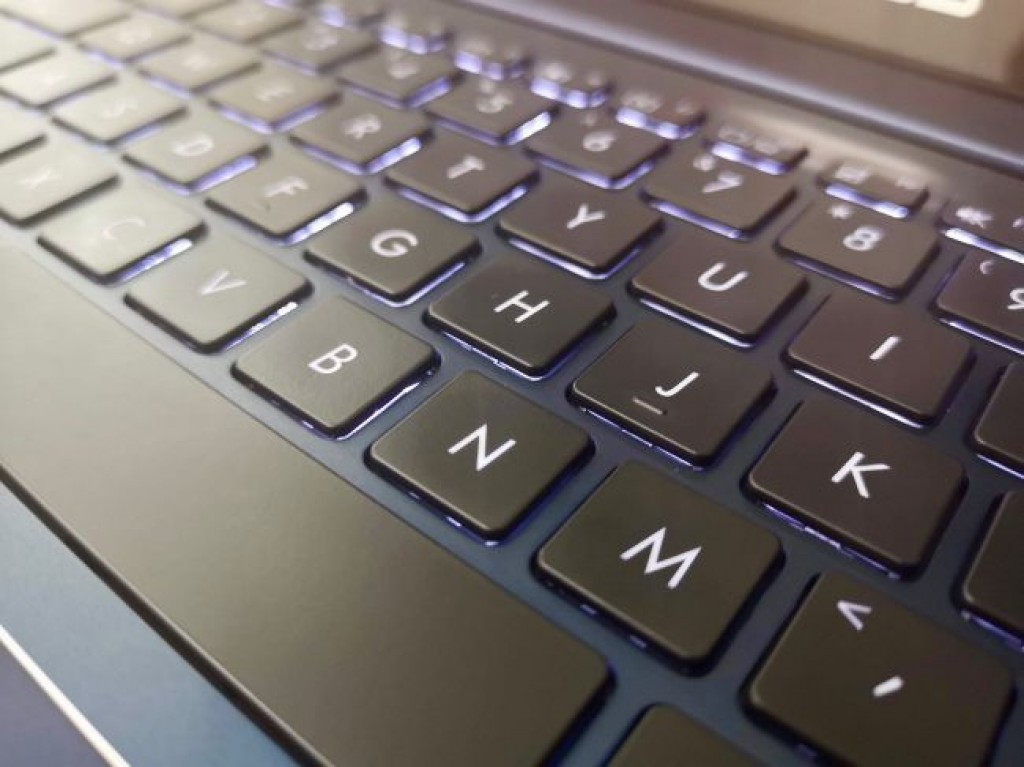
Fingerprint sensor is finally in the right place
Thankfully, Asus has come to terms with the fact a fingerprint sensor does not belong on the touchpad. We’ve long complained about having to work around an Asus fingerprint reader in the top-right corner of the touchpad, making it awkward to move documents around or use gestures.
The fingerprint reader now sits just below the right arrow key, and is far more convenient to use. Thanks, Asus.
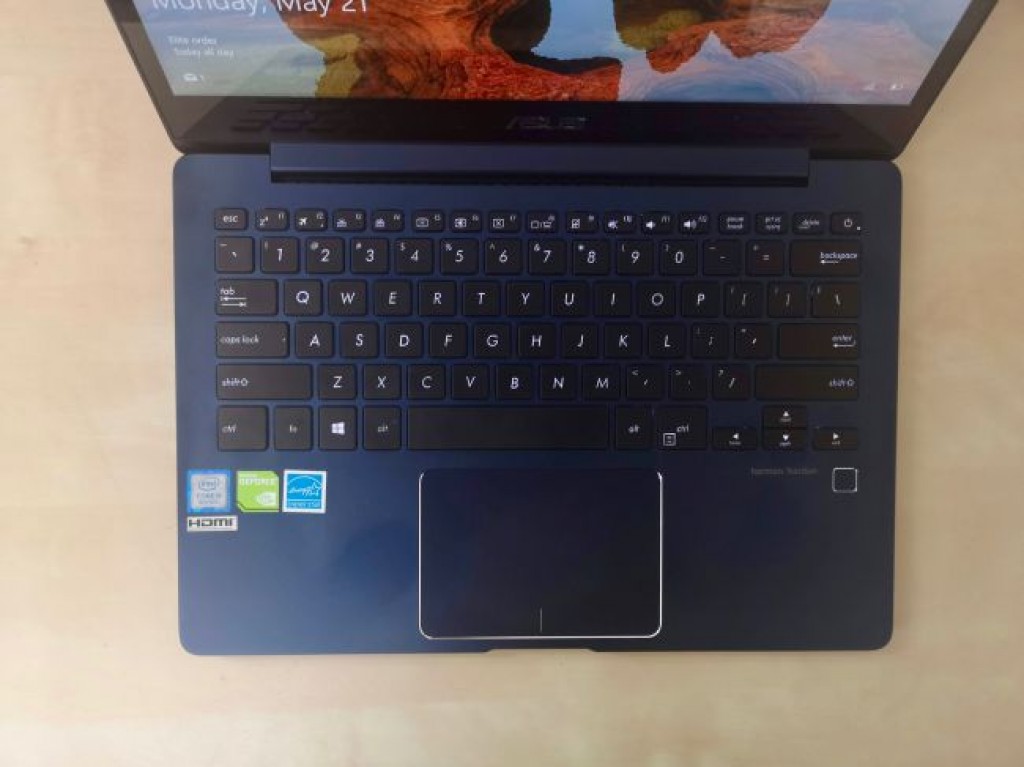
Let’s talk touchpad
With the fingerprint sensor out of the way, this is the first time we’ve had a change to truly get a feel for an Asus touchpad. The touchpad works with gestures, but almost too well.
When using two fingers to scroll down a webpage, we often accidentally trigger the zoom function in Google Chrome. The gestures are different enough (two finger swipe and pinch-to-zoom) that we are a bit puzzled by the mixup.
Over the course of a week, we’ve put the ZenBook 13 through our daily work routines. There was plenty of Slack messages, Chrome tabs, streaming of music and everything else in between. There was even a bit of casual gaming on our review model.
The addition of an Nvidia GeForce MX150 shows in looking at our benchmark results. The ZenBook nearly pulls off a complete sweep against the Spectre 13, save for the single-core Geekbench test. The results aren’t just a few points different, either. For example, the 3DMark scores are nearly double that of the Spectre 13.
In daily use, the ZenBook 13 starts off a big sluggish, but as it warms up, any slowness disappears and it performs without any hiccups or issues. At multiple times we had many Chrome tabs and windows open and switching between them, along with multiple apps and emails arriving at a rapid pace without any issues.
As we previously said, we didn’t test out any intense games, but did take some time to play a few online games and found it to get the job done without issue. You can expect to play more casual games without a problem, but anything more intense might drag.
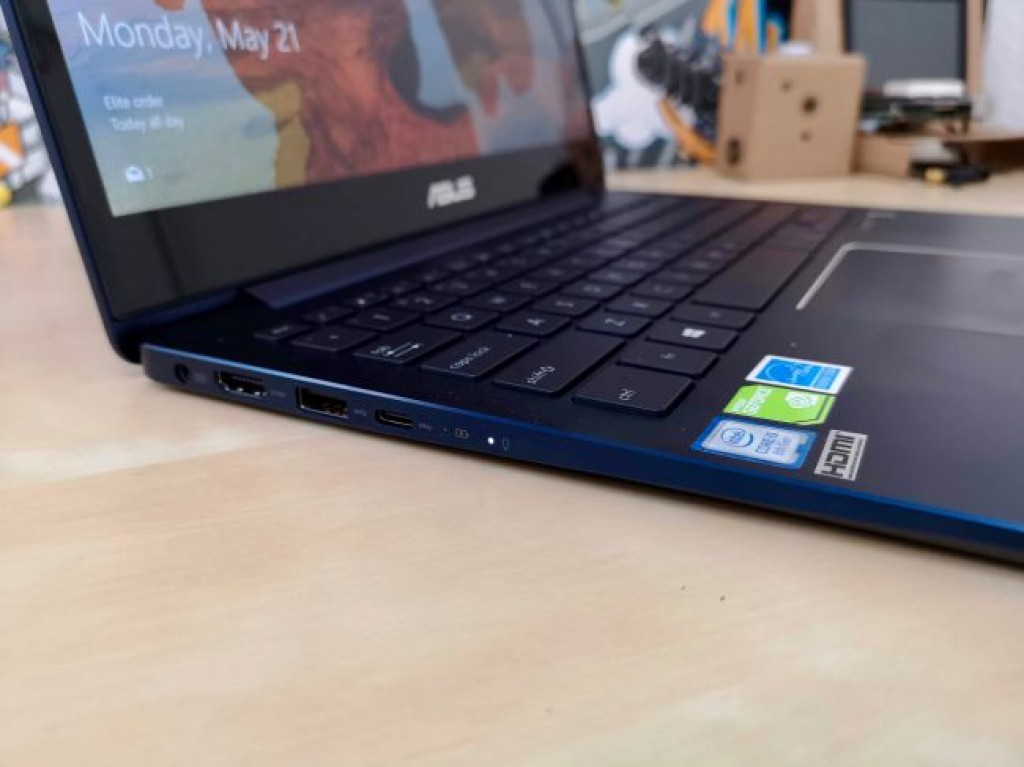
Battery life
Through our tests and daily use, we are able to confidently say the ZenBook 13 has a battery that’s more than enough to get you through a cross country flight, or through a day of meetings.
The PCMark 8 battery test came in at 3 hours and 49 minutes, but the movie test was a strong 6 hours and 38 minutes. That’s not the longest battery life we’ve seen from an Ultrabook by a longshot, though it’s reasonably long enough.
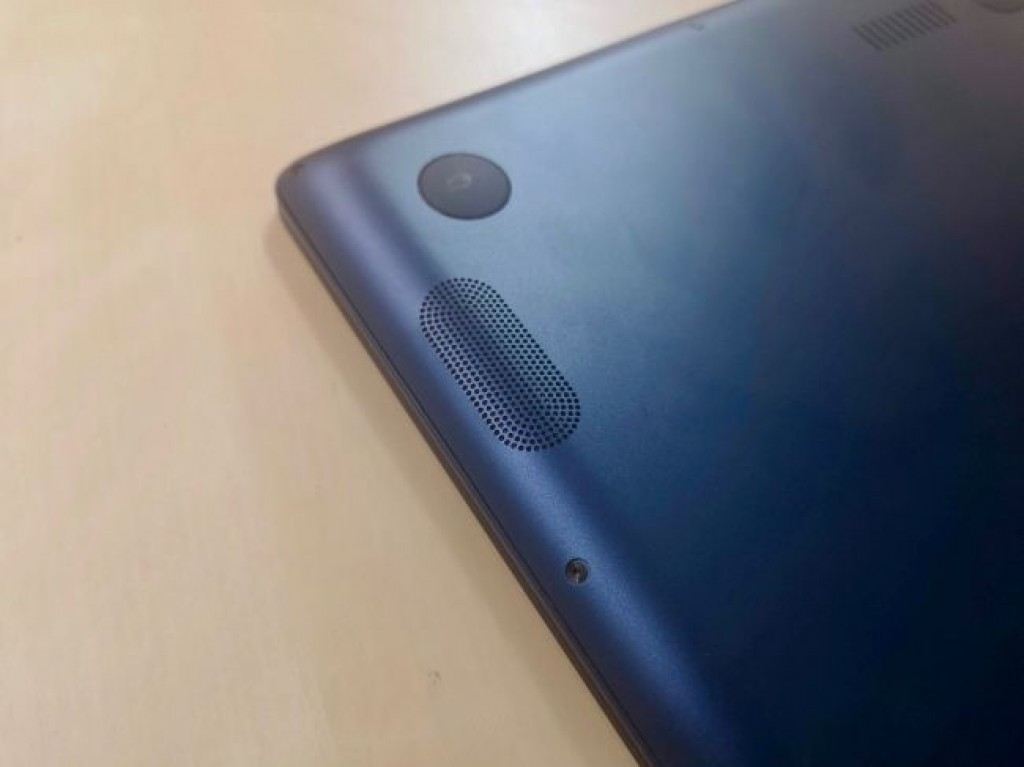
Speakers
Smaller laptops don’t normally have the best sound output, and unfortunately that is also true with the ZenBook 13. The speakers sound muffled, even when sitting flat on a desk, without any real power or robust sound behind them.
If you do opt to play any games or listen to music on this laptop, you’ll want to use some headphones or earbuds.
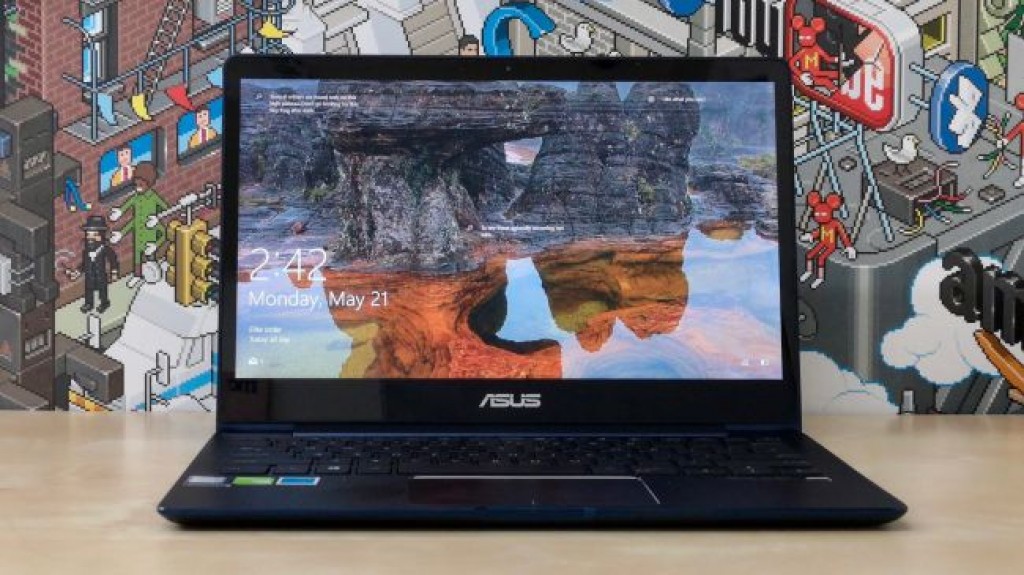
Final verdict
The ZenBook 13 is a competitively priced laptop that offers more than enough power for the casual user and the occasional video editor. It’s not going to be enough to get through intense Fortnite rounds, but for the casual gamer it should get by.
The super reflective lid is a magnet for fingerprints, which is either going to upset you or not matter at all. One of the smaller, yet most important, highlights of this particular model is the fingerprint reader’s new location – freeing up the touchpad. It’s unfortunate that the touchpad, then, is frustrating to use.
Overall, the flaws with the ZenBook 13 aren’t deal breakers, but caveats that you deserve to be made aware of regarding this otherwise impressive Ultrabook.
Source: techradar.com





































